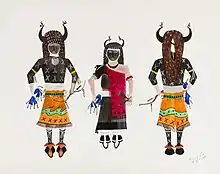Oqwa Pi | |
|---|---|
.jpg.webp) | |
| Born | 1899 San Ildefonso Pueblo, New Mexico, U.S. |
| Died | 1971 (aged 71–72) Los Alamos, New Mexico, U.S. |
| Other names | Abel Sanchez, Red Cloud, Ogwa-Pi, Oqua Pi, Aqua Pi, Kachina Stick |
| Occupation(s) | painter, muralist, politician |

Oqwa Pi (English: Red Cloud[1] or Kachina Stick) also known as Abel Sanchez (1899–1971), was a San Ildefonso Pueblo painter, muralist, and politician. Pi was known for his brightly colored paintings.[1] He served as governor of the San Ildefonso Pueblo for six terms.[1]
Biography
Oqwa Pi was born in 1899 in San Ildefonso Pueblo (Tewa: P'ohwhóge Owingeh) in New Mexico.[2] He was educated at the Santa Fe Indian School, where he learned watercolor and mural paintings;[3] he studied with Dorothy Dunn. The Indian School later commissioned him to create murals at the school. He then returned to the pueblo where he married and had a number of children.[2]
In 1931, the Exhibition of Indian Tribal Arts at the Grand Central Galleries in New York City happened, and as a result, Pi's work toured and was shown nationally including at the Museum of Modern Art.[4][5] He attended the Santa Fe Indian School, studying under Dorothy Dunn.[6] Pi has a mural at the Santa Fe Indian School, in the dining room.[7]
Oqwa Pi's paintings were executed in one of the two specific styles that are associated with the San Ildefonso school, a Native art movement of self-taught artists from 1900 to 1935. His subjects include festivals, dances and native ceremonies.[1] Regarding his paintings of Native ceremonial dances, his son Gilbert, also a painter, stated that Oqwa Pi painted spiritual, but not secretive dances that "didn't exploit their spirituality in a senseless way".[8]
Pi also was a politician, having served serving six terms as governor of San Ildefonso Pueblo.[1]
Later in life, Pi and his wife move to Santa Fe, New Mexico to live. Pi died in 1971 in Los Alamos, New Mexico.[2] Two of his sons became painters, Gilbert Sánchez,[8] and Ramos Sánchez (born 1926).[9] His grandson, Russell Sánchez is a painter and potter.[10]
Collections
His work is included in museum collections including at the Smithsonian American Art Museum,[2] Detroit Institute of Arts,[11] Museum of Fine Arts, Houston,[12] Brooklyn Museum,[3] Ackland Art Museum,[13] and Denver Art Museum.[14]
See also
References
- 1 2 3 4 5 Lough, Alex Wagner (February 28, 2011). "Native American Watercolors". Brandeis.edu. Robert D. Farber University Archives & Special Collections, Brandeis University. Retrieved 2021-12-09.
- 1 2 3 4 "Oqwa Pi". Smithsonian American Art Museum (SAAM). Retrieved 2021-12-09.
- 1 2 "Oqwa Pi aka Abel Sanchez – San Ildefonso Pueblo, 1889-1971". Brooklyn Museum. Retrieved 2021-12-09.
- ↑ Iverson, Peter; Davies, Wade (2014-07-23). "We Are Still Here": American Indians Since 1890. John Wiley & Sons. p. 90. ISBN 978-1-118-75170-1.
- ↑ Indians at Work. United States Bureau of Indian Affairs. Washington D.C.: United States Bureau of Indian Affairs. February 15, 1936. p. 22.
{{cite book}}: CS1 maint: others (link) - ↑ "Abel (Oqwa Pi) Sanchez - Biography". Askart.com. Retrieved 2021-12-09.
- ↑ "Deer Dance". Metropolitan Library System. Retrieved 2021-12-09.
- 1 2 Scott, Sacha T. (2020). "Ana-Ethnographic Representation: Early Modern Pueblo Painters, Scientific Colonialism and Tactics of Refusal". Arts. 9 (6): 6. doi:10.3390/arts9010006.
- ↑ "Ramos Sanchez". Adobe Gallery. Retrieved 9 December 2021.
- ↑ "Russell Sanchez, San Ildefonso Pueblo Artist". Adobe Gallery. Retrieved 9 December 2021.
- ↑ "Abel Sanchez". Detroit Institute of Arts (DIA).
- ↑ "Oqwa Pi (Abel Sánchez)". The Museum of Fine Arts, Houston.
- ↑ "Abel Sanchez (Oqwa Pi)". ackland.emuseum.com. Retrieved 2021-12-09.
- ↑ "Man and Buffalo". Denver Art Museum. Retrieved 2021-12-09.